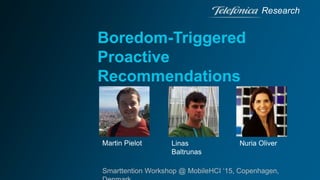
Boredom-Triggered Proactive Recommendations
- 1. Boredom-Triggered Proactive Recommendations Research Smarttention Workshop @ MobileHCI ‘15, Copenhagen, Martin Pielot Linas Baltrunas Nuria Oliver
- 2. Attracting attention is essential to many services SocialMediaCube. Yoel Ben-Avraham. Apr 8, 2013 via Flickr. CC BY-ND 2.0
- 4. Average revenue per user in Q1 2014 $7.2
- 5. Average revenue per user in Q1 2014 $7. $45
- 7. Our engagement is now defined by push-driven notifications rather than the traditional pull-driven experience. We’re “hunting and pecking” through our app grid a lot less; the apps that notify us (without over-notifying to the point of uninstall) are rewarded with our engagement
- 8. Proactive Recommendations on Mobiles
- 9. 30% off of your next beverage ordered at Starbucks in Diagonal Mar
- 11. Not all products have intuitive
- 12. by Jakob Nielsen on August 20, 2007 Banner blindness
- 13. ‚Attention is a limited resource—a person has only so much of it ‘ [Matthew B. Crawford] Attention Economy: treating human attention as a scarce commodity [Davenport and Beck, 2001] times square night 2013. chensiyuan. Apr 16, 2013 via Wikipedia. CC BY-SA 4.0
- 14. Attention is not always scarce Show them this photo if someone said technology … . Adam Rifkin. May 21, 2014 via Flickr. CC BY
- 15. Attention is not always scarce Show them this photo if someone said technology … . Adam Rifkin. May 21, 2014 via Flickr. CC BY Boredom displeasure caused by “lack of stimulation or inability to be stimulated thereto.” [Fenichel, 1951]. “a bored person is not just someone who does not have anything to do; it’s someone who is actively looking for stimulation but it is unable to do so” [Eastwood, 2002]
- 16. Attention is not always scarce Mobile phones are a commonly used tool to fill or kill time when bored [Brown et al. 2014] Show them this photo if someone said technology … . Adam Rifkin. May 21, 2014 via Flickr. CC BY Boredom displeasure caused by “lack of stimulation or inability to be stimulated thereto.” [Fenichel, 1951]. “a bored person is not just someone who does not have anything to do; it’s someone who is actively looking for stimulation but it is unable to do so” [Eastwood, 2002]
- 17. Attention is not always scarce Mobile phones are a commonly used tool to fill or kill time when bored [Brown et al. 2014] Show them this photo if someone said technology … . Adam Rifkin. May 21, 2014 via Flickr. CC BY Boredom displeasure caused by “lack of stimulation or inability to be stimulated thereto.” [Fenichel, 1951]. “a bored person is not just someone who does not have anything to do; it’s someone who is actively looking for stimulation but it is unable to do so” [Eastwood, 2002]
- 18. Detecting Boredom from Mobile Phone Usage UbiComp ’15, Osaka, Japan
- 19. Experience Sampling Right now, I feel bored [5-point Likert scale] ca. 6 times per day Preferably triggered when phone in use Borapp
- 20. Category Example Feature Explanation Context Semantic Location Home, work, other, unknown Demographics Age, gender 38, female Last Communication Activity Time last incoming call Time passed since somebody called the participants Usage (intensity) Bytes received Number of bytes downloaded in the last 5 minutes Usage (externally triggered) Number of notifications Number of notifications received in the last 5 minutes Usage (idling) Number of apps Number of apps launched in the last 5 minutes Usage (type) Most used app App used for the most time in the last 5 minutes. 35 Features, 7 Categories
- 21. Data Collection 54 Participants For two weeks in July 2014 Over 40,000,000 usage logs 4398 valid self-reports of boredom
- 22. 34.7% 42.8% 48.3% 52.1% 56.6% 62.4% 66.2% 70.1% 74.3% 76.3% 0% 20% 40% 60% 80% 100% 0% 20% 40% 60% 80% 100% Precision Recall Precision: 70.1% for 30% recall, 62.4% for 50% recall 74.6% AUCRO C
- 23. Borapp2 Model running on Mobile Phone Using primary data set with normalized ground truth and no proneness scores Constantly predicts when user is bored on the fly
- 25. Data Collection 16 Participants For two weeks in Feb 2015 941 Buzzfeed recommendations 48% when predicted bored
- 26. Click-ratio Fraction of times people clicked on notification 8% when not bored 20.5% when bored (as inferred by the model) Difference significant z = -2.102, p = .018 Large effect r = -.543
- 27. Engagement-ratio Fraction of times people spent more than 30 sec reading 4% when not bored 15% when bored (as inferred by the model) Difference significant z = -2.102, p = .018 Large effect r = -.511
- 28. When predicted bored, people were … More likely to click More likely to read for > 30 seconds
- 29. Background Recommendations fuel many of the big, free internet services Shift from banners (desktop) to proactive recommendations (mobile) Problem Attention is limited Uncontrolled notification / recommendation spamming => banner blindness Solution When bored, attention is not scarce – stimuli seeking emotional state Use boredom as trigger for content-independent proactive recommendations Contribution from related research Evidence that boredom can be predicted from mobile phone usage When predicted bored, more open to proactive recommendations Martin Pielot Linas Baltrunas Nuria Oliver Research Smarttention Workshop @ MobileHCI ‘15, Copenhagen, Boredom-Triggered Proactive Recommendations
Editor's Notes
- https://www.flickr.com/photos/epublicist/8631257903
- 8 cents per day http://marketrealist.com/2015/02/average-revenue-per-user-is-an-important-growth-driver/
- 8 cents per day http://marketrealist.com/2015/02/average-revenue-per-user-is-an-important-growth-driver/
- https://www.flickr.com/photos/ifindkarma/14237942074/
- https://www.flickr.com/photos/ifindkarma/14237942074/
- Source: http://commons.wikimedia.org/wiki/File:Bored,_bored,_bored_(7949872568).jpg
- Source: http://commons.wikimedia.org/wiki/File:Bored,_bored,_bored_(7949872568).jpg
- Source: http://commons.wikimedia.org/wiki/File:Bored,_bored,_bored_(7949872568).jpg
